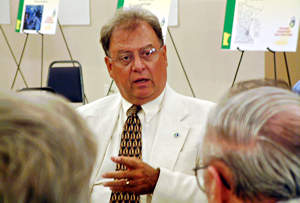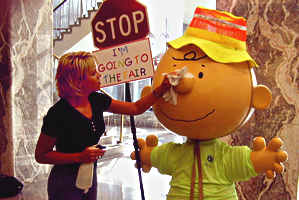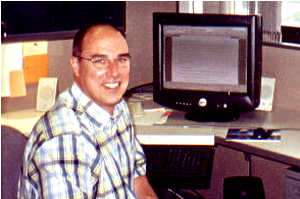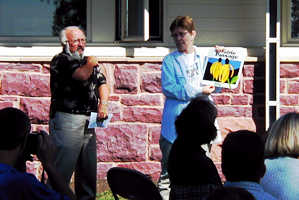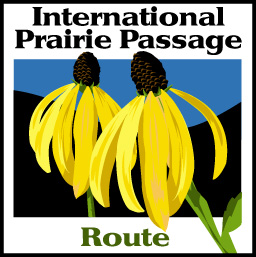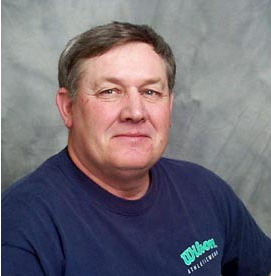

| Governor, commissioner make case for increased investments in transportation Marv Lunceford celebrates 51 years with MnDOT Program celebrates contributions of African-Americans, Indians to transportation | ||||||
| Fergus Falls provides lively start to statewide Transportation Dialogues series | ||||||
Some 35 transportation stakeholders and citizens attended a Transportation Dialogue in Fergus Falls Aug. 13, to learn about and discuss Mn/DOT’s 20-year Statewide Transportation Plan, "Moving Minnesota 2003: Moving people and freight to 2023." The dialogue was the first in an eight session series that will crisscross Minnesota throughout the months of August and September. Dialogue participants represented local governments, businesses, law enforcement, elected officials and the general citizenry. Doug Weiszhaar, Mn/DOT’s deputy commissioner kicked off the session by encouraging the participants to express their concerns and opinions about transportation in Minnesota. "We want you to tell us how transportation in Minnesota should look," said Weiszhaar as he presented Mn/DOT’s vision of a future transportation system that is coordinated and fully integrated. Participants helped shape the discussion as they voted for the three of the policies in the plan that were most important to them. Small group discussion further defined their issues and concerns about transportation. Some participants voiced their wishes for transportation, saying they want to see:
Mn/DOT’s planning staff will incorporate comments heard at the dialogue sessions into the final plan, which will be given to the Minnesota Legislature in January 2003. News about the statewide plan and the dialogues hit the news stands this week as well. Commissioner Elwyn Tinklenberg outlined his vision in articles in the Star Tribune and Pioneer Press. The public can view the whole plan, vote on the plan’s policies and offer their opinions on Mn/DOT’s Web site or at Mn/DOT's State Fair exhibit from Aug. 22-Sep. 2. By Lucy Kender |
||||||
| Clarification offered on state budget directive | ||||||
Last week’s Mn/DOT Newsline article about a Department of Finance directive that all state agencies develop 10 percent budget reduction plans for FY 2004-2005 generated lots of calls. "It’s nice to know so many employees are reading Newsline!" said editor Craig Wilkins. "However, the words ‘10 percent reductions’ caused concern." While it is likely that Mn/DOT may experience some budget cuts, many things need to happen before any cuts actually get implemented, according to Kevin Gray, chief financial officer. "Budget preparations identifying cuts for the next biennium will ultimately be determined by the next Legislature and wouldn’t go into effect until July 1, 2003," Gray said. "Any budget plans prepared when there is going to be a change in administration are subject to the review and direction of that new leadership. There will be lots of number crunching before any cuts are a done deal." Assistant group directors are charged with developing budget reduction plans that outline various scenarios for review in case they are needed in the future. The goal of these statewide reductions is to make up for a budget deficit of $1.6 - $2.7 billion for the next biennium. Budget reduction scenarios are expected to affect all funds—including $72 million a year from construction. This may result in additional project deferrals as well as cuts to aeronautics, state aid and transit funds. Gray said that Mn/DOT’s current business planning and budget proposal processes will help in developing reduction plans as well as support budget investment proposals that will be an alternative to the 10 percent budget reduction plans. "We are going great guns with business planning and the entire department has made a stellar effort on this," Gray said. "Business planning and Shaping Our Future efforts have helped us prioritize our activities and sustain those that are most highly valued by our customers," said Deputy Commissioner Doug Weiszhaar. "We have not had to reduce our staffing nor our department operating budget as a result of recent initiatives, which have helped us stay ahead of the game." Even in the face of possible budget cuts, Mn/DOT will not focus on staff reductions. As Weiszhaar indicated last week, Mn/DOT has the potential to lose 65 percent of its engineering and technical workforce to retirement and attrition by 2007. "Shaping Our Future helped Mn/DOT identify a baseline program level that will allow us to maintain a skilled workforce," Weiszhaar said. "We will only use consultants if the program stays higher than that level. Our decision to use consultants for the program will help us be flexible in our response to funding changes in order to minimize the impact on our workforce. "There is enormous public support for investing in transportation," he added. "This could change the outcome of any proposed budget reductions at Mn/DOT." By Donna Lindberg |
||||||
| Get in the ‘zone’ at Mn/DOT’s State Fair exhibit | ||||||
Freshened up with a bright, new yellow-green T-shirt, a newly cleaned head and an extra dab of sunscreen on his nose, Work Zone Safety Charlie Brown stands ready for a heavy-exposure tour of duty at the Minnesota State Fair. From the fair’s opening on Aug. 22 until its closing on Labor Day, Sept. 2, Charlie will welcome visitors to the Mn/DOT exhibit at Judson Avenue east of the fair’s Dairy Building. New at the exhibit this year are a 511 road information call demonstration, a commuter rail photo cutout board and a straw poll to measure how the public would like Mn/DOT to rank its priorities. The exhibit, titled the "Mn/DOT Zone," will also invite visitors to learn the difference between commuter rail and light rail, examine ways Mn/DOT’s intelligent transportation system projects promote safety and efficiency and vote on their favorite wildflower or new color for road salt. Each day, employees from throughout the department will staff the "District Zone" where transportation projects from their area will be displayed. The children’s area will have work zone safety illustrations for coloring, and the information counter will hand out pencils and postcards featuring the state’s transportation innovators. By Craig Wilkins |
||||||
| International communications organization will honor Electronic Communications' Mike Hogan | ||||||
Mike Hogan, communications planning director, Electronic Communications, will garner national recognition for his contributions in the electronic communications field. On Thursday, Aug. 15, Hogan will receive a lifetime membership in the Association of Public Safety Communications International at its annual conference in Nashville, Tenn. To earn this award, association members must have served as president and/or made significant contributions in the field. "I am surprised by the nomination," Hogan said. "I did most of my work—18 years—with the state of Nebraska. It is nice for the Minnesota Chapter of APCO to recognize my contributions." Since becoming a member in 1978, Hogan served as Nebraska chapter president, vice president of the Minnesota chapter, board member of the APCO Frequency Advisory Committee and member of the national Public Safety Wireless Advisory Committee. State agencies including Mn/DOT, Public Safety and Natural Resources have benefited from Hogan’s efforts to improve their communications and service to Minnesota citizens. The award citation notes Hogan’s role in development of the 800-megahertz digital radio system that, when implemented, will markedly improve communication among fire, police, sheriff, State Patrol, Mn/DOT and other public service agencies in the Twin Cites metro area. By Maya Beecham |
||||||
| New ‘Prairie Passage’ route to help preserve prairie patches | ||||||
Gathering near a patch of virgin prairie in Blue Mounds State Park near Luverne, state and federal officials met on Saturday, Aug. 10 to dedicate the new Prairie Passage route that extends from Minnesota to Texas. During ceremonies observing Prairie Day, officials from the Federal Highway Administration, U.S. Fish and Wildlife Service, the Minnesota Department of Natural Resources and Mn/DOT unveiled signs that will denote the Prairie Passage routes. The new route from Minnesota to Texas via Iowa, Missouri, Kansas and Oklahoma will raise awareness about the nation’s prairie heritage, link prairie regions and create a national prairie wildflower corridor. Eighty signs will go up in Minnesota to designate prairie routes, prairie remnants and cultural and historic links to the prairie. Officials unveiling the signs included Bonnie Harper-Lore, FHWA landscape ecologist; Cheryl Heide, DNR regional director; and Doug Haeder, state aid engineer with Mankato/District 7. The signs’ designer is Paula Gustafson, graphic artist, Environmental Services. Other Prairie Day activities included a bird watching hike at Blue Mounds and re-creations of early prairie life at Redwood Falls and Jeffers, said Kathy Bolin, Environmental Services, Mn/DOT coordinator for the program.
The celebration and the new Prairie Passage program share similar goals:
At the dedication, Harper-Lore said, "Today Prairie Passage serves as the connecting ribbon between six states for this model partnership. By pooling resources, the states will be able to protect and restore their natural heritage and promote our cultural heritage by linking people and places to the prairie." By Craig Wilkins |
||||||
| High water levels get July grain shipments rollin’ on the river | ||||||
High water levels on the Mississippi River this summer caused some trouble for recreational boaters, but Minnesota shippers enjoyed a banner month in July, moving nearly 1,100 barges containing about 56 million bushels of grain to market. The picture differs greatly from last year when floods hampered river shipping and many shipments were transferred by truck or rail to the Duluth-Superior port for shipping via the Great Lakes. This year, barges were loaded at river ports in Minneapolis, St. Paul, Savage, Red Wing and Winona for shipment to ocean-going freighters at New Orleans. Dick Lambert, director, Ports and Waterways, said this year’s grains—mainly corn, soybeans and wheat—are destined for markets in countries such as Japan, Korea, Indonesia, Mexico and several nations in the Middle East. The volume of the grain shipped in July would fill the Hubert H. Humphrey Metrodome in Minneapolis and spill over up to 40 feet deep on adjacent city streets, according to Lambert. Another measure of the grain shipped, he said, shows the reduction in the number of train and truck shipments that would have occurred were it not for river shipping. One barge carries the load equivalent of 15 jumbo hopper cars or 58 fully loaded semi-trailer trucks, Lambert said. Shipping by river, he added, reduces train traffic and cuts wear on the state’s highways made by grain trucks. "In addition to reducing the number of rail trips, river shipping has the potential to increase profits to farmers because large cooperative shippers such as Harvest States can return more of their earnings to growers when shipping costs are lower," Lambert said. By Craig Wilkins |
||||||
| Mn/DOT issues latest version of state’s traffic control devices manual | ||||||
Mn/DOT released the new edition of the Minnesota Manual on Uniform Traffic Control Devices, the guide that outlines standards for traffic control devices such as signs, signals and pavement marking for the state. The new edition is the first published by Mn/DOT in 10 years. The manual derives from the federal manual but adds additional standards and guidelines that put an increased emphasis on motorist and worker safety, said Doug Weiszhaar, deputy commissioner. Citing work zone construction signs as an example, Weiszhaar noted that the federal minimum size is 36 inches while Minnesota’s minimum is 48 inches. The new manual also contains new items such as use of mandatory "four-way" or "all-way" signs beneath all stop signs at four-way stop intersections. It also introduces standards for roundabouts, traffic circles with entrances and exits. Also new in the latest MUTCD are standards for audible pedestrian signals that inform people with visual impairments when it is safe to cross a roadway. Public and private transportation engineers and planners use the manual for road design, traffic sign installation and maintenance, and the design and manufacture of traffic control devices. Mn/DOT distributes one fee copy to county engineers and to city engineers with cities having a population of 5,000 or greater. The manual can be purchased for $80 or viewed at Traffic Engineering’s Web site. |
||||||
| Slayton’s Jim Zimmerman adds dramatic rescue to spouse’s family reunion | ||||||
A routine family trip to Utah ended in a dramatic rescue by Jim Zimmerman, a transportation generalist at the Willmar District’s Slayton Truck Station. While trout fishing at a reservoir with his brothers-in-law, Zimmerman observed a 90-year-old man fishing nearby from a rock ledge. Later, they heard a splash and realized the man had fallen into the water in attempt to retrieve his dropped fishing pole. When Zimmerman ran to the scene, he noticed that the man was making no attempt to get out of the reservoir. Zimmerman then jumped into the frigid water to pull the man to safety. Zimmerman and his companions thought very little of the experience until later, whe he received a copy of the Beaver Press from Beaver, Utah. The Press ran a thank-you note from Charles Green, the man whose life he had saved. Zimmerman still doesn’t know how Green learned his name and address, but does appreciate the gesture. When later recounting his story to the Murray County News, Zimmerman said, he instinctively knew he had to attempt the rescue. "A short, fat man shouldn’t be doing that, but it had to be done," he said. By Craig Wilkins |
||||||
Minnesota Government
links: Northstar | Governor's
Office
Search Internal
Web Site |
Mn/DOT
External Web site
General questions: info@dot.state.mn.us
| Feedback
/ Suggestions
